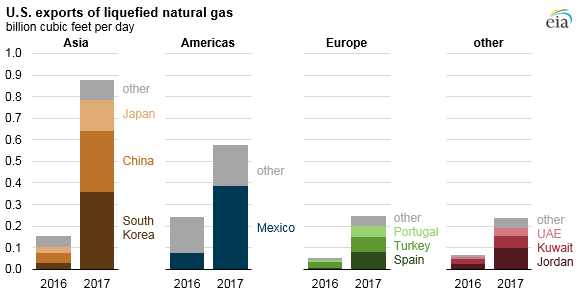US exports of LNG reached 1.94 billion cubic feet per day (Bcf/d) in 2017, up from 0.5 Bcf/d in 2016. As LNG exports increased, shipments went to more destinations. US LNG exports in 2017 were all from Louisiana’s Sabine Pass liquefaction terminal, and reached 25 countries.
53% of US LNG exports in 2017 were shipped to three countries:
- Mexico;
- South Korea;
- China.
Mexico received the largest amount of U.S. LNG exports, at 20% of the 2017 total. An increasing natural gas demand in Mexico, and delays in the construction of pipelines connecting to US export pipelines led Mexico to rely on LNG imports to supplement imports of natural gas by pipeline.
In Asia, exports to South Korea accounted for 18% of total US LNG exports in 2017 and were part of long-term contracts between sellers Cheniere Energy and Shell and the Korean KOGAS and KEPCO. Exports to China were 15% of total U.S. LNG exports.
[smlsubform prepend=”GET THE SAFETY4SEA IN YOUR INBOX!” showname=false emailtxt=”” emailholder=”Enter your email address” showsubmit=true submittxt=”Submit” jsthanks=false thankyou=”Thank you for subscribing to our mailing list”]
About 60% of US LNG in 2017 was sold on a spot basis to more than 20 countries in Asia, North and South America, Europe, the Middle East and North Africa, and the Caribbean.
Europe was the third-largest share of US LNG exports. LNG imports by several European countries increased in 2017, because of increased demand from the power generation sector. South American LNG imports declined in 2017. Demand for natural gas in that region is affected by the availability of competing lower-cost natural gas supply and hydro generation output.
Four LNG projects will begin in the next two years: Elba Island LNG in Georgia, Cameron LNG in Louisiana in 2018, Freeport LNG, and Corpus Christi LNG in Texas in 2019.
Once completed, US LNG export capacity is expected to reach 9.6 Bcf/d by the end of 2019, and the US are expected to become the third-largest LNG exporter in the world by 2020, surpassing Malaysia and remaining behind Australia and Qatar.































































